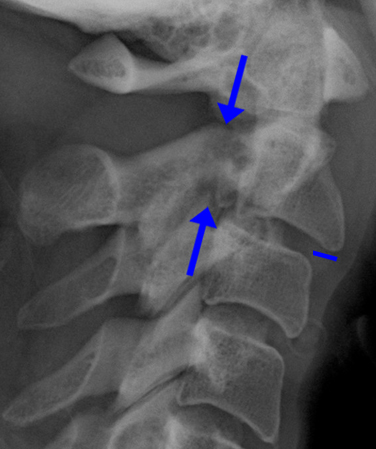Spine Case 7 Diagnosis
Hangman's Fracture
Diagnosis
Diagnosis is via lateral cervical spine radiographs or CT scan. Besides the fracture line:
- Look for prevertebral soft tissue swelling
- Assess alignment of the vertebrae as assessed by intact anterior spinal, posterior spinal, and spinolaminar lines (it should be possible to draw a smooth curved line touching all 7 cervical vertebrae at each of these locations without interruption).
Any soft-tissue swelling or disruption of normal lines, in the setting of trauma, suggests occult fracture or ligamentous injury.
Caveat:
In children under 8, ligamentous laxity of the upper C-spine can cause anterior displacement of C2 on C3, a normal variant called pseudosubluxation, which can be confused with an acute ligamentous injury. Up to 4 mm or 40% subluxation of C2 on C3 is normal in the pediatric population (but not in adults).
If in doubt:
- Look for soft tissue swelling (absent in pseudosubluxation)
- Take an extension film (displacement decreases or resolves in extension if due to pseudosubluxation)
- Check Swishuk's line (the line drawn in the additional image between the anterior aspects of the spinous processes of C1 and C3—in pediatric pseudosubluxation, it will be within 2 mm of the anterior aspect of the C2 spinous process).
